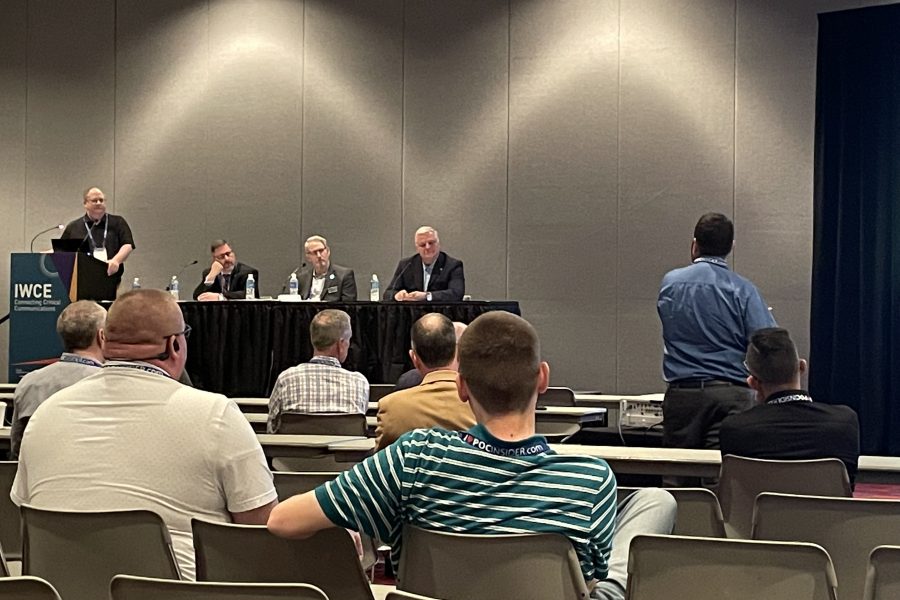4.9 GHz presents opportunity for public safety but requires the right management, IWCE speakers say
Natural disasters, crisis situations and mass casualty events don’t happen often, but when they do, radio frequencies are inundated with traffic. This infrequent, high-bandwidth need prompted the Federal Communications Commission (FCC) to reserve 50 megahertz of spectrum in the 4940-4990 GHz band specifically for public safety usage in 2002.
For years, innovators were not sure how best to use bandwidth within that frequency range. This resulted in a patchwork of offerings being introduced into the market, from ad-hoc mesh-networking to point-to-point technologies.
“Even as late as 2010, in the National Broadband Plan, the basic consensus was that anything over 3 GHz was junk, unless you were doing microwave,” said IWCE’s Urgent Communications Editor Donny Jackson while moderating a panel session Wednesday titled “4.9 GHz: What Now?” at IWCE 2023 in Las Vegas. “No one knew what to do with those higher frequencies.”
But now, access technology can harness that frequency range and beyond—5G technology even leverages millimeter-wave bands—and regulators are reconsidering the bandwidth’s purpose.
Citing underutilization of the 4.9 band at the time, FCC commissioners issued a rules in late 2020 that would have allowed states to license the airwaves to commercial operators, but that initiative was halted just a few months later. Recently, the FCC voted to approve proposed rules that would reiterate public safety’s use of the band and would establish a single 4.9 GHz band manager that would provide coordination capabilities and help develop an ecosystem of solutions that operate on the spectrum.
The FCC has extended the comment period for the 4.9 GHz item until the middle of April. Much of the conversation has so far centered around what characteristics a band manager should have and who the band manager should be.
“My perspective is tainted by 32 years of public service, and when I look at a problem like this, I’m looking to solve public-safety issues. I’m not looking to solve any sort of commercial problem,” said Jeff Johnson, chief executive of Western Fire Chiefs and a panelist for Wednesday’s session. “We need a single license nationwide, and a single, technological approach.”
Johnson, who was instrumental in lobbying for the creation of the First Responder Network Authority (FirstNet Authority) in 2012 and served on its board of directors for six years after, wasn’t vague about which entity he thinks should be allowed to operate on the bandwidth.
“I have a strong belief that, one way or another, 4.9 [GHz} should end up in FirstNet’s authority,” Johnson said, noting his bias. “Obviously, I’m a fan of it, because FirstNet has proven wildly successful.”
There is a notable counterargument. FirstNet, an independent government authority, was built out and is currently managed by AT&T. Some question whether it might be better to spark healthy competition within the sector by opening bidding to other third-party operators, or to create another organization entirely to manage the 4.9 GHz band.
At least some industry thought leaders said they believe FirstNet is in the best position to create a public safety-centric ecosystem for the creation of devices and technology around bandwidth.
“If you look at the experience of FirstNet, and the industry that’s grown up around it, why would not the same thing happen around 4.9?” said Dan Munsey, fire chief and warden at the San Bernardino County (Calif.) Fire Department, speaking at an earlier IWCE 2023 session Monday titled “Public Safety Spectrum Issues.” “With 5G and the potential for this, they know there’s a market for this. They know they can sell (new technologies and devices). Nothing is for certain in this economic environment, but it’s much more certain. We want that innovation in public safety.”
Apart from which entity should manage the 4.9 GHz band, everyone who spoke on the topic during various sessions at IWCE 2023 agreed there’s room to share, as long as public-safety users have priority and preemptions rights when they need to utilize the spectrum.
“There are times when we use a lot of it, and there are times when we don’t use it at all. The question is, ‘can commercial organizations/tech use that bandwidth while it’s not being used?’” asked Chris Moore, retired chief of the San Jose (Calif.) Police Department during Monday’s panel. He concluded that an arrangement could be reached on the condition that, when it’s needed by public safety, “we need to be able to use it all.”
Finding an acceptable balance would be beneficial to both stakeholders, as the frequency would receive more usage with public safety prioritized, and it would also be a catalyst for innovation and industry.
Conversation also focused on how the bandwidth can be used. Harlin McEwen, former chair of the FirstNet Authority Public Safety Advisory Committee and a retired police official, noted during Monday’s question-and-answer section that public-safety organizations “need to focus on the future, and that’s 5G technology. One of the things this band is perfect for is using 5G technology for public-safety use.”
John Foley, managing director of the Safer Buildings Coalition, said Wednesday that “4.9 [GHz] holds some great potential to address the in-building safety problem.” These days, “a big chunk of public safety operates in the built environment,” and a majority of 911 calls are made indoors. “When you do the math, it’s got to work in buildings.”
Leveraging the technology behind Wi-Fi routers to create a high speed “express lane for public safety that rides over commercial networks” is feasible on the 4.9 GHz band, Foley continued. “The FirstNet experiment has proven that it can attract public-private investments into the industry. That’s what this opens up.”














